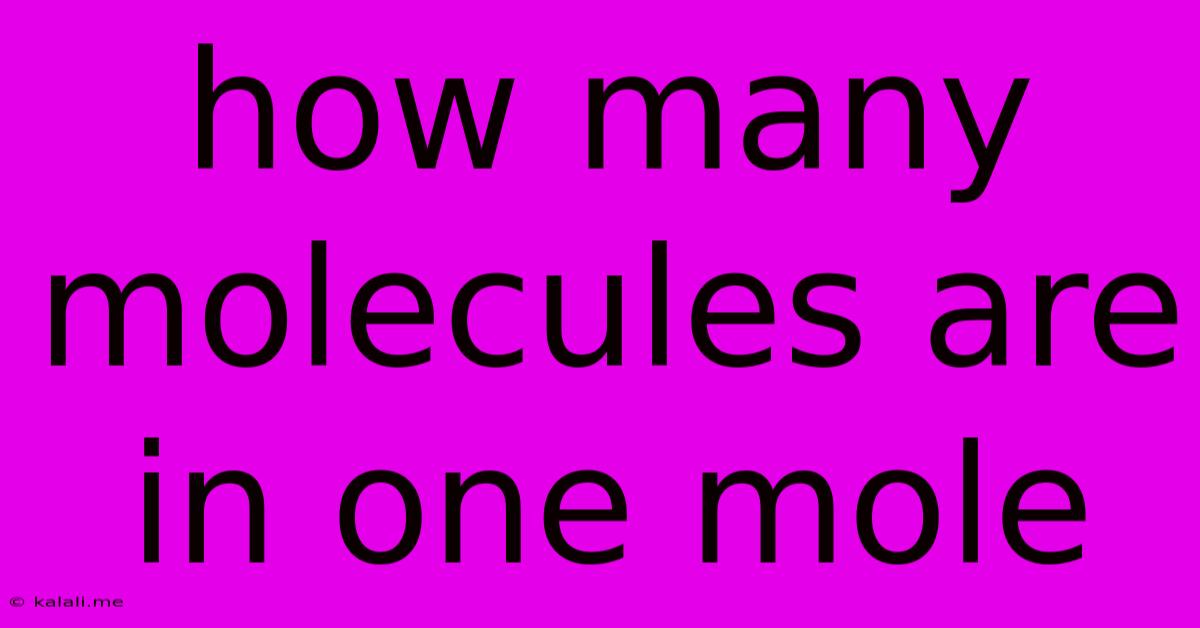How Many Molecules Are In One Mole
Kalali
Jun 15, 2025 · 3 min read

Table of Contents
How Many Molecules Are in One Mole? Avogadro's Number Explained
This article explains the fundamental concept of a mole in chemistry, focusing on the crucial question: how many molecules are in one mole? We'll explore Avogadro's number and its significance in understanding chemical quantities. Understanding moles is essential for accurate calculations in stoichiometry and other chemical processes.
A mole is a fundamental unit in chemistry used to measure the amount of a substance. It's not a measure of mass or volume, but rather a measure of the number of particles—atoms, molecules, ions, or formula units—present in a substance. This number is incredibly large, and that's where Avogadro's number comes in.
Avogadro's Number: The Key to Understanding Moles
Avogadro's number is approximately 6.022 x 10<sup>23</sup>. This immense number represents the number of constituent particles (atoms, molecules, ions, etc.) found in one mole of any substance. It's a constant, meaning it remains the same regardless of the substance being measured. This consistent relationship is what makes the mole such a powerful tool in chemistry.
Think of it like this: a dozen eggs always contains 12 eggs, regardless of the size or type of eggs. Similarly, one mole of any substance always contains 6.022 x 10<sup>23</sup> particles.
Why is Avogadro's Number Important?
Avogadro's number provides a bridge between the microscopic world of atoms and molecules and the macroscopic world of laboratory measurements. It allows chemists to:
- Relate mass to the number of particles: Using molar mass (the mass of one mole of a substance), we can convert between grams and the number of moles, and subsequently, the number of particles.
- Perform stoichiometric calculations: Avogadro's number is crucial for balancing chemical equations and calculating the amounts of reactants and products in chemical reactions.
- Understand concentrations: Molarity, a common unit of concentration, is defined as the number of moles of solute per liter of solution. This relies directly on the concept of the mole and Avogadro's number.
Calculating the Number of Molecules
To calculate the number of molecules in a given number of moles, simply multiply the number of moles by Avogadro's number. For example:
- One mole of water (H₂O) contains 6.022 x 10<sup>23</sup> water molecules.
- Two moles of carbon dioxide (CO₂) contains 2 * (6.022 x 10<sup>23</sup>) = 1.204 x 10<sup>24</sup> carbon dioxide molecules.
This simple calculation highlights the power and practicality of using moles in chemistry.
Beyond Molecules: Applying Avogadro's Number
While we've primarily focused on molecules, it's important to remember that Avogadro's number applies to any type of particle. For example:
- One mole of sodium atoms (Na) contains 6.022 x 10<sup>23</sup> sodium atoms.
- One mole of sodium chloride (NaCl) formula units contains 6.022 x 10<sup>23</sup> NaCl formula units.
The versatility of Avogadro's number is what makes it an indispensable tool in the chemist's arsenal.
In conclusion, one mole contains 6.022 x 10<sup>23</sup> particles. This seemingly large number is fundamental to understanding and working with chemical quantities. Avogadro's number allows chemists to seamlessly bridge the gap between the microscopic world of atoms and molecules and the macroscopic world of chemical reactions and measurements. Understanding this concept is essential for success in chemistry.
Latest Posts
Latest Posts
-
Which Of The Following Is Not An Equation
Jun 16, 2025
-
The Opportunity Cost Of Holding Money
Jun 16, 2025
-
Which Of The Following Statements Is True Regarding A Vpn
Jun 16, 2025
-
The Rorschach Inkblot Test Is An Example Of
Jun 16, 2025
-
Maximum Deflection In A Cantilever Beam
Jun 16, 2025
Related Post
Thank you for visiting our website which covers about How Many Molecules Are In One Mole . We hope the information provided has been useful to you. Feel free to contact us if you have any questions or need further assistance. See you next time and don't miss to bookmark.